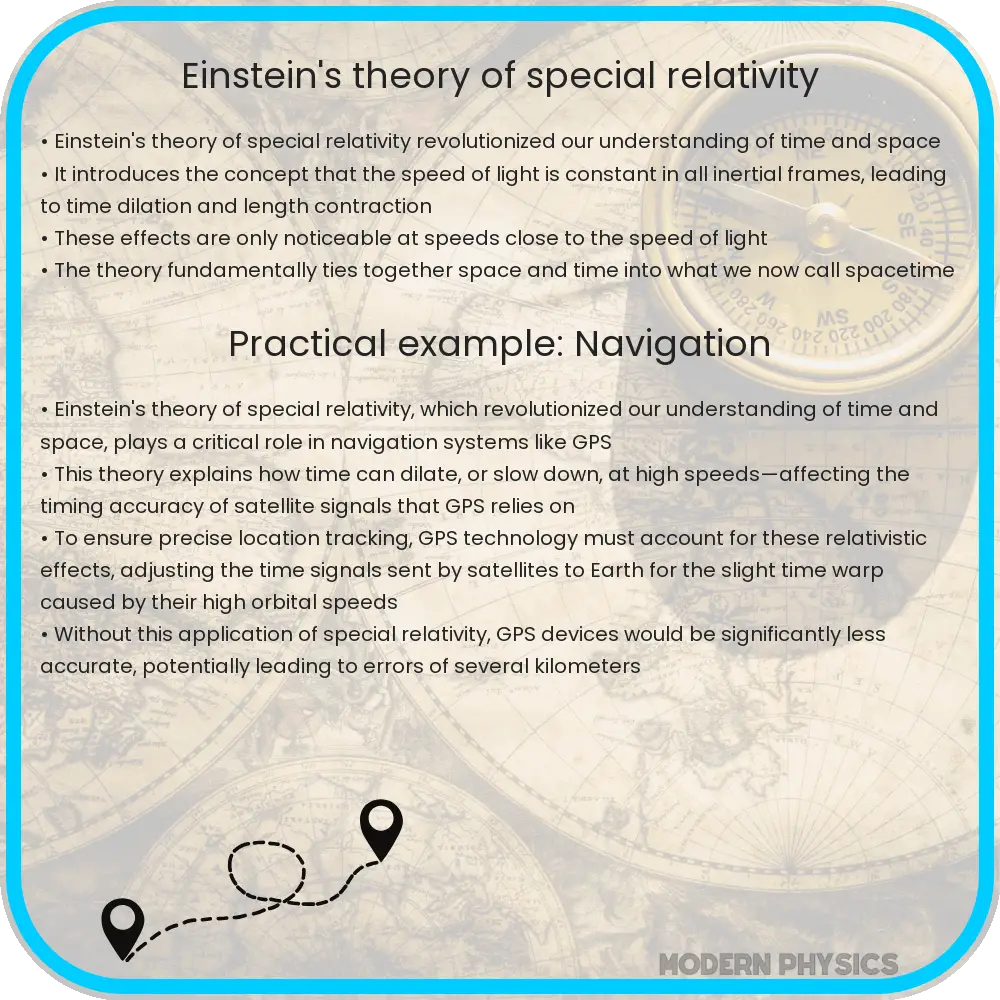Explore Einstein’s Theory of Special Relativity, covering time dilation, space contraction, E=mc2, and its impact on modern physics and technology.

Understanding Einstein’s Theory of Special Relativity
The Theory of Special Relativity, introduced by Albert Einstein in 1905, marks a significant milestone in modern physics. It revolutionized our understanding of space, time, and energy, laying the groundwork for contemporary cosmological and quantum theories. At its core, this theory comprises two fundamental postulates that challenge traditional Newtonian mechanics.
The Core Postulates
The first postulate asserts the Principle of Relativity, which states that the laws of physics are the same in all inertial frames of reference. This means that whether you are stationary or moving at a constant velocity, the basic physical laws will appear identical. The second postulate centers on the Constancy of the Speed of Light, proposing that the speed of light in a vacuum is the same for all observers, regardless of their relative motion or the motion of the light source.
Time Dilation: A Consequence of Special Relativity
One of the most intriguing aspects of Special Relativity is time dilation. Time dilation implies that time can pass at different rates in different reference frames. When an object moves relative to an observer, its clock seems to tick slower. This effect is most noticeable at speeds close to the speed of light and is mathematically described by the equation: \( t’ = \frac{t}{\sqrt{1 – \frac{v^2}{c^2}}} \), where \( t’ \) is the time observed in the moving frame, \( t \) is the time in the observer’s frame, \( v \) is the velocity of the moving object, and \( c \) is the speed of light.
Space Contraction and the Ultimate Speed Limit
Similarly, Special Relativity predicts length contraction in the direction of motion. This means an object in motion will appear shorter in the direction of its movement to a stationary observer. The ultimate speed limit imposed by the theory is the speed of light itself. According to Einstein, nothing can travel faster than light in a vacuum, a fundamental principle that underpins much of modern physics.
In conclusion, Einstein’s Theory of Special Relativity has profound implications for our understanding of the universe. It challenges our perceptions of time and space, introducing concepts like time dilation and space contraction. These principles have not only been confirmed by experimental evidence but continue to influence modern science and technology.
Mass-Energy Equivalence: E=mc2
A groundbreaking aspect of Special Relativity is the concept of mass-energy equivalence, encapsulated in the famous equation \( E=mc^2 \). This equation implies that mass and energy are interchangeable; a small amount of mass can be converted into a vast amount of energy, and vice versa. This principle is crucial in understanding nuclear reactions and has far-reaching implications in both theoretical physics and practical applications like nuclear power and medical imaging technologies.
Experimental Verifications
The predictions of Special Relativity have been confirmed through numerous experiments. Time dilation has been directly observed in particles traveling at high speeds and in precise atomic clocks on airplanes, which show a slight difference in time compared to clocks on the ground. Similarly, the mass-energy equivalence has been substantiated through observations in particle accelerators, where particles gain mass as they are accelerated to speeds close to the speed of light.
Implications for Modern Physics
Einstein’s theory has had a profound impact on modern physics, laying the foundation for the field of quantum mechanics and influencing the development of technologies like GPS, which requires relativistic adjustments to function accurately. The theory also leads to paradoxes like the famous “twin paradox,” where a twin traveling at high speed would age slower than their identical sibling on Earth, illustrating the non-intuitive nature of high-speed physics.
Conclusion
Albert Einstein’s Theory of Special Relativity fundamentally changed our understanding of the universe. Its principles of time dilation, space contraction, and mass-energy equivalence challenge the conventional notions of space and time. Beyond its profound theoretical implications, the theory has practical applications in various fields, from GPS navigation to nuclear energy. As we continue to explore the vastness of the universe, the insights provided by Special Relativity will undoubtedly remain pivotal in guiding our scientific and technological advancements.
